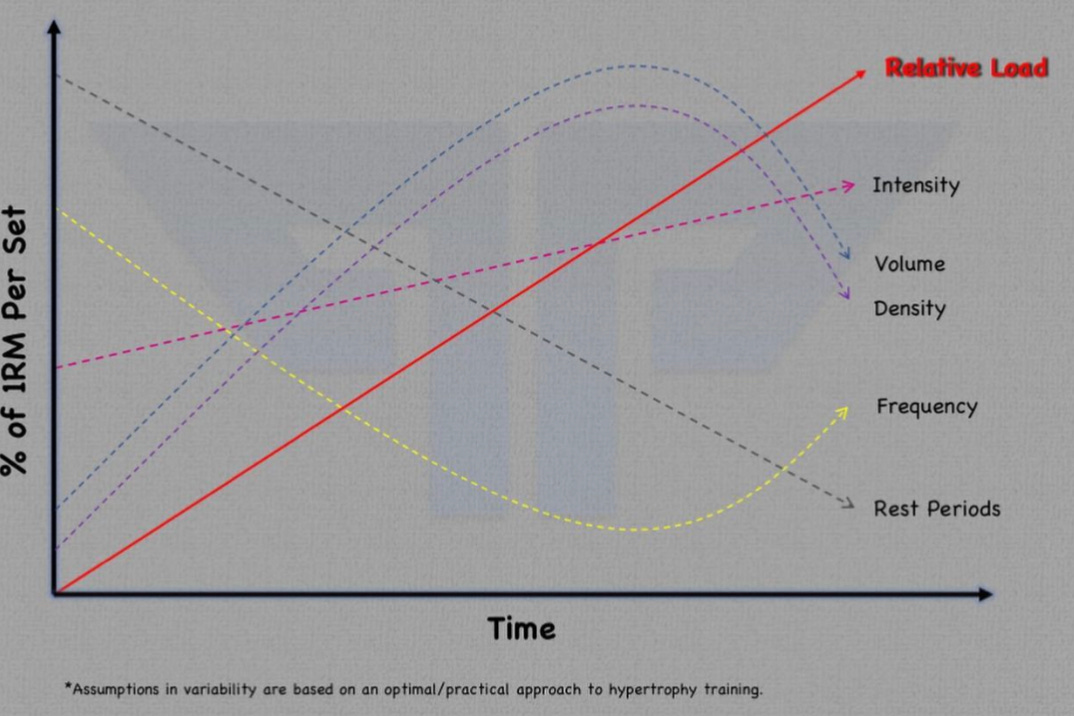A measure of load used as a percentage of one-rep-max.
Onto the oft overlooked and misunderstood but extremely important — linear changes in RELATIVE LOAD (across all sets)
- All set volume is performed on a single bodypart/lift versus divided up systemically (i.e. all sets inferred to be from leg extension/biceps curls/etc)
- Volume- 15 sets per week
- Density- 1:1 ratio with volume
- Frequency- 2x/wk
- Intensity- 3RIR
- Rest Periods- 3 min between sets
The effects discussed — and graphed — are going to be a function of an isolated comparison between our independent variable (here, relative load) and a dependent variable (we will evaluate them one at a time). The above parameters will act as standardization values when those variables are not being compared directly to volume.
Volume
Interestingly, we see a very non-intuitive relationship between volume and RL when adhering to the parameters established for the other variables. When RL is on the lower end of the stimulatory range (~30% of 1RM), we actually CANNOT tolerate a ton of volume because of the amount of fatigue generated from taking these sets close to failure. As we push closer 100%, each set (unit of volume) becomes more efficient with regards to effective reps, compared to the “junk” reps that are also adding to fatigue. This actually allows us to perform more volume at higher RLs — up to the point where the systemic fatigue of very heavy loads surpasses the stimulus. This is why recommendations for hypertrophy generally fall between ~65%-85%.
Density
As with volume, density will follow a modified bell-curve when tracking changes in RL — The highest densities can be achieved in the middle of the effective RL range.
Frequency
Based off 15 sets-per-week taken to 3RIR, we can conclusively say that frequency will inversely mirror volume (and density) when we adjust RL within hypertrophic ranges. Sets within the lower end (~30-60%) and higher end (~90+%) will necessitate more recovery due to the increased demands placed on the body during each bout (though the demands are qualitatively different on each side of the spectrum). In the middle ground, we can reduce the time needed between bouts because the balance of local/systemic stressors is more harmonious with recovery capabilities.
Intensity
Because the name of the game here is efficiency of effort, we have to evaluate where on the spectrum of intensity that varying RLs are going to provide the best ratio of stimulus-to-fatigue. We know pretty well that fatigue will be generated disproportionately when lower RLs sets are taken close to failure. We also know that as we get closer to our 1RM, we will have a greater proportion of effective reps available within each set. Nothing is definitive when it comes to intensity, but it would seem that a slow increase in proximity to failure (as RL increases) would be our best bet when trying to manage the interplay between these two variables.
Rest Periods
Though it may seem as though higher RLs necessitate longer rest periods, that assumption gets aborted very quickly when you take a set of 20 close to failure on squats. When training for strength, rest will almost always be longer when working with higher RLs, but hypertrophy comes with its own sets of rules — this relationship seems to diverge when the intensity of the set (3RIR) is factored in. Because we have to take respiratory recovery into account (especially with compound variations), we can get away with shorter rest periods as RL increases, provided intensity stays fixed.
Damn this was a tricky one!
Relative load and its relationship to muscle growth has been a hot topic in the evidence-based world in the past few years. This is prior recommendations deifying the 6-12 rep range (~65-85%) was found to be a gross oversimplification — the true hypertrophic range seems to be far more vast (~3-30 rep range). While this allows for a ton more variability within programming and periodization models, it also comes with caveats that are not immediately apparent on paper.
Maintaining equilibrium across all these variables was already difficult. Now, it’s damn-near impossible to control for all the counterfactuals that have beencreated by the injection of fluidity into relative load.
More so than any of the other variables, RL has a lot of grey area. This can be seen as an opportunity or a pitfall. So take the time to familiarize yourself with how each pole of the RL spectrum can affect (positively and negatively) the other variables — as well as fatigue and recovery. It’s not easy but it’s worth it.

